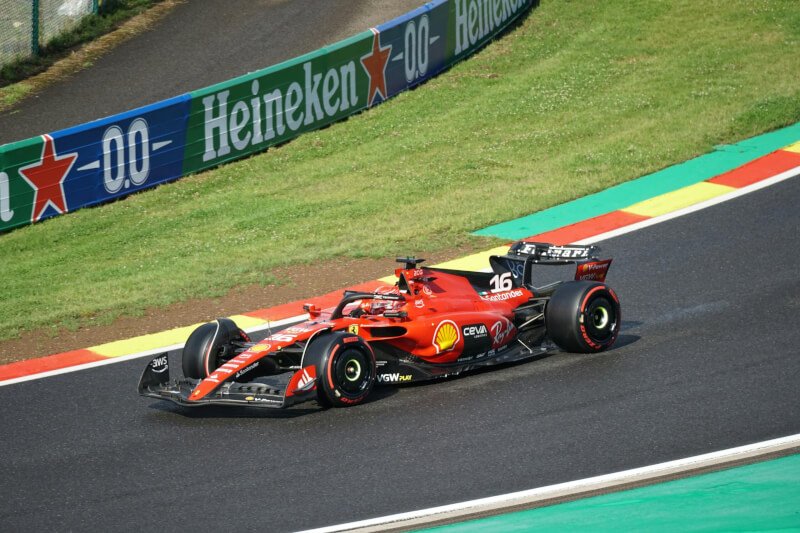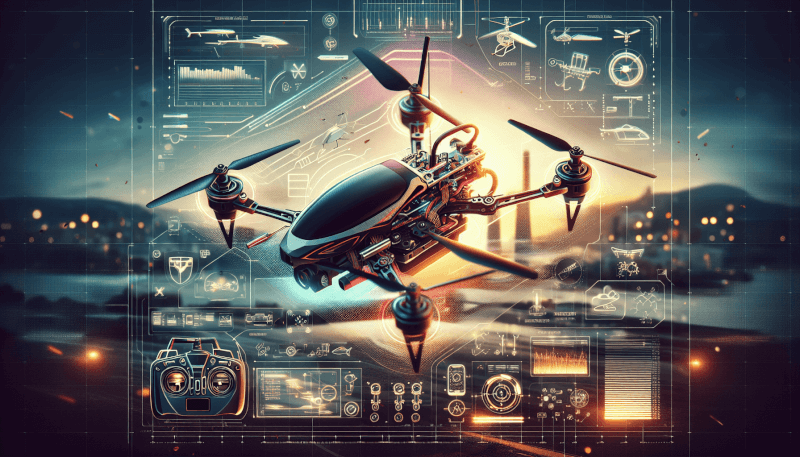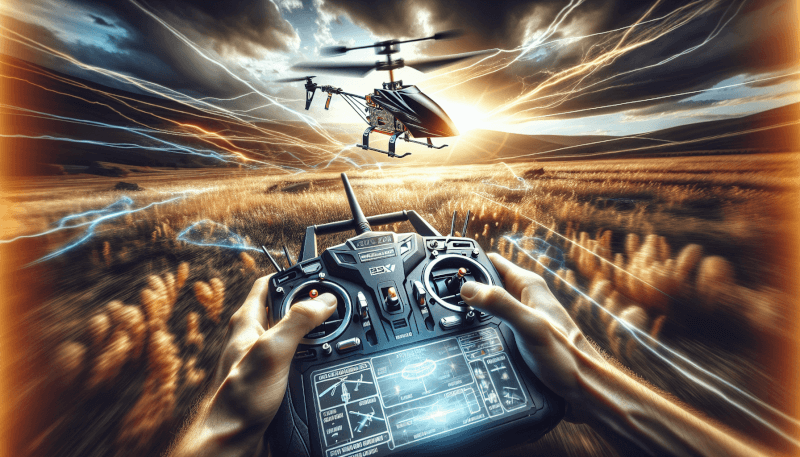So you’ve just gotten your hands on a brand new RC helicopter, and you’re itching to take it for a spin? Well, get ready to kick things up a notch because we are about to introduce you to the exciting world of FPV racing! In this article, we will help you get started with FPV racing on your RC heli. Strap in and prepare for an adrenaline-fueled adventure as we guide you through the basics of FPV racing, from choosing the right gear to mastering the art of piloting from a first-person perspective. Let’s soar to new heights and experience the thrill of FPV racing on your RC heli like never before!
Understanding FPV Racing
What is FPV Racing?
FPV racing, short for First Person View racing, is a thrilling and immersive form of RC (Remote Control) heli racing where pilots fly their aircraft using a live video feed transmitted from an onboard camera. In this exciting sport, you are not just remote controlling your heli from the ground but actually experiencing the flight as if you were sitting in the cockpit.
How does FPV Racing work?
FPV racing works by equipping your RC heli with an FPV camera and transmitter, which send a live video feed to your FPV goggles or monitor on the ground. You wear the FPV goggles to see exactly what your heli sees, giving you a first-person view of the exhilarating flight. With the camera and transmitter installed, you can navigate through challenging tracks, perform daring maneuvers, and race against other FPV pilots.
Why choose FPV Racing for your RC heli?
FPV racing offers an adrenaline-pumping, immersive flying experience that takes your RC heli hobby to the next level. It combines the thrill of high-speed racing with the excitement of flying from a first-person perspective. FPV racing allows you to explore new flying techniques, engage in friendly competition, and connect with a vibrant community of fellow racing enthusiasts. It’s an exhilarating way to challenge your piloting skills and experience the sheer joy of FPV flight.
Choosing the Right Equipment
Finding a suitable RC heli for FPV Racing
When selecting an RC heli for FPV racing, it’s important to consider factors such as speed, agility, and durability. Look for helis specifically designed for FPV racing, as they often feature lightweight frames, powerful motors, and responsive controls. Opt for a model with good crash resistance to withstand the occasional mishap during races.
Selecting the appropriate FPV camera and transmitter
Choosing the right FPV camera and transmitter is crucial for a clear and stable video feed. Look for a high-definition camera with low latency for real-time video transmission. Consider the camera’s field-of-view (FOV) to ensure a wide-angle view of your surroundings. The transmitter should have sufficient power output and the appropriate frequency range for reliable transmission.
Choosing a compatible FPV goggles or monitor
FPV goggles or a monitor allows you to view the live video feed from your heli’s camera. When selecting FPV goggles, look for a comfortable fit, adjustable head straps, and good image quality. Consider factors such as resolution, field of view, and diversity receiver capabilities. If you prefer using a monitor, ensure it has sufficient screen size and a clear display to provide an immersive FPV experience.
Additional equipment and accessories to consider
To enhance your FPV racing experience, there are several additional equipment and accessories to consider. These include a reliable radio transmitter and receiver for precise control, spare batteries and chargers to keep you flying for longer periods, an antenna tracker to improve video signal reception, and a GPS module to track your heli’s speed and location accurately.

Preparing Your RC Heli for FPV Racing
Installing the FPV camera and transmitter on your RC heli
Carefully install the FPV camera and transmitter on your RC heli following the manufacturer’s instructions. Securely mount the camera on the heli’s frame, ensuring it has an unobstructed view of the flight path. Connect the camera’s wiring to the transmitter, and then attach the transmitter to a suitable location on the heli, ensuring it is secure and protected from vibrations.
Adjusting the camera angle for optimal viewing
To capture the best footage and maintain a clear view during flight, adjust the camera angle to suit your flying style and racing preferences. Experiment with different angles to find the optimal position that provides a good balance between capturing the forward view and allowing for better maneuverability. Secure the camera in the desired angle using adjustable mounts or adhesive tape.
Securing the camera and transmitter wiring
It’s crucial to secure the camera and transmitter wiring to prevent them from getting tangled or damaged during flight. Use zip ties or cable management clips to tidy up the wiring and keep it away from moving parts. Additionally, consider using adhesive-backed hook and loop fasteners to secure the camera and transmitter in place, ensuring they remain stable and unaffected by vibrations.
Configuring the video transmission settings
Before taking to the skies, ensure that you configure the video transmission settings for optimal performance. Check for interference by selecting a clean frequency and adjusting the transmitter’s power output according to the range you intend to race. Make sure the video feed is stable and free from lag or artifacts by adjusting video transmission channels and antenna positioning. Fine-tuning these settings will greatly enhance your FPV racing experience.
Setting Up Your FPV Ground Station
Arranging your FPV goggles or monitor
When setting up your FPV ground station, arrange your FPV goggles or monitor in a comfortable and accessible position. Ensure that the goggles fit securely on your head and that the monitor is positioned at an appropriate distance for easy viewing. Consider using a ground station platform or mounting system to keep your equipment organized and stable during racing sessions.
Connecting the receiver to your goggles or monitor
To receive the live video feed from your heli’s transmitter, you need to connect the receiver to your FPV goggles or monitor. Follow the manufacturer’s instructions to properly connect the receiver using compatible cables. Ensure that the connection is secure and that the receiver is powered correctly to receive the video signal.
Ensuring a stable power source for your ground station
To avoid interruptions during FPV racing, ensure a stable power source for your ground station. Use a reliable battery pack or power supply that can provide sufficient power for your goggles or monitor, receiver, and any additional equipment connected to your ground station. It’s a good practice to carry spare batteries or a power bank to extend your racing sessions without worrying about losing power.
Checking the video signal strength
Before taking off, check the video signal strength to ensure a stable and uninterrupted FPV experience. Walk around the racing area while monitoring the video feed on your goggles or monitor to identify any areas with weak signal strength or interference. Consider adjusting the placement or orientation of your receiver’s antenna to optimize signal reception and minimize the chances of video dropout during races.

Learning the Basics of FPV Racing
Understanding flight modes and controls
To become a skilled FPV racer, it’s crucial to understand the different flight modes and controls available on your RC heli. Familiarize yourself with the concepts of throttle control, yaw control, pitch control, and roll control. Spend time mastering these controls in different flight modes, such as stabilized mode and acro mode, to gain confidence and improve your maneuverability during races.
Practicing throttle and yaw control
Throttle control and yaw control play a significant role in FPV racing. Practice adjusting your heli’s throttle smoothly and precisely to maintain a consistent altitude during races. Similarly, practice yaw control to execute sharp turns and navigate through tight corners. Gradually increase the speed and complexity of your maneuvers as you gain confidence in your throttle and yaw control skills.
Mastering FPV flying techniques
Mastering FPV flying techniques is key to becoming a skilled racer. Work on smooth and precise flight movements, maintaining steady control inputs, and minimizing abrupt maneuvers that can lead to crashes. Focus on maintaining a visual line of sight with your heli, anticipating upcoming obstacles, and adjusting your flight path accordingly. Regular practice and experimentation will help you refine your FPV flying techniques.
Learning to navigate through obstacles
FPV racing often involves navigating through challenging obstacles and courses. Practice flying through gates, around flags, and between trees to improve your obstacle avoidance skills. Start with simple courses and gradually increase the complexity to challenge yourself. Learning to judge distances accurately and adjusting your speed and trajectory will help you navigate through obstacles smoothly and successfully.
Choosing an Appropriate Flying Location
Finding an open and spacious area
When selecting a flying location for FPV racing, choose an open and spacious area with plenty of room to maneuver your RC heli. Look for locations such as empty fields, large parks, or designated RC flying clubs. The more open space you have, the less chance there is for collisions and accidents while racing. This will allow you to fly freely and focus on honing your racing skills without worrying about obstacles or bystanders.
Avoiding areas with potential hazards
It’s crucial to avoid flying in areas with potential hazards that could pose a risk to your heli or others. Stay away from airports, helipads, or any locations where manned aircraft operate. Avoid flying near power lines, tall buildings, or dense tree canopies that could interfere with your signal or cause accidents. Prioritize safety by ensuring a clear and hazard-free flying environment.
Considering local regulations and permissions
Before flying your RC heli for FPV racing, familiarize yourself with local regulations and obtain any necessary permissions. Some areas may have restrictions on RC flying or specific rules for FPV racing. Ensure that you comply with these regulations to avoid legal issues and maintain a positive image for the FPV racing community. Respect private property and obtain permission if needed before flying on someone else’s land.
Taking weather conditions into account
Weather conditions play a significant role in FPV racing. Choose days with favorable weather conditions, such as clear skies, minimal wind, and good visibility. Flying in strong winds or adverse weather conditions can be risky and affect your control over the heli. Ensure proper weather monitoring and plan your racing sessions accordingly to make the most out of your FPV racing experience.

Safety Guidelines for FPV Racing
Always fly with a spotter or companion
Ensure that you always fly with a spotter or companion when participating in FPV racing. The spotter’s role is to keep an eye on your heli from a different perspective and provide real-time feedback and guidance. They can help you avoid collisions, notify you of any potential hazards, and assist in troubleshooting if any issues arise during your races.
Maintain a safe distance from people and property
Maintaining a safe distance from people and property is of utmost importance for FPV racing. Always fly in designated areas away from crowds and ensure that you are aware of your surroundings. Respect other people’s privacy and property by avoiding flying near houses, vehicles, or public spaces where people may be at risk. Safety should always be your top priority to avoid accidents or causing damage.
Wear appropriate protective gear
To ensure your safety during FPV racing, always wear appropriate protective gear. This includes goggles or safety glasses to protect your eyes from debris, a helmet to protect your head in case of crashes, and knee and elbow pads to prevent injuries. It’s better to be prepared and protected than to risk injury during intense racing sessions.
Inspect your equipment regularly
Regularly inspecting your equipment is crucial to ensure the safety and reliability of your RC heli. Before each race, thoroughly check the heli for any signs of damage or wear and tear. Pay close attention to the frame, motors, propellers, and wiring. Ensure that all connections are secure and that the heli is in proper working condition. Regular maintenance and inspection will help prevent potential accidents during FPV racing.
Joining FPV Racing Communities
Finding local FPV racing groups or clubs
Joining local FPV racing groups or clubs is an excellent way to connect with like-minded individuals and enhance your FPV racing experience. Search online or ask fellow RC heli enthusiasts for information on local racing communities. Participating in group events and meetups will not only broaden your network but also provide opportunities for friendly competitions and collaborative learning.
Participating in organized FPV racing events
Participating in organized FPV racing events is an excellent way to test your skills against other experienced racers and showcase your abilities. Look for local, regional, or national FPV racing events in your area and register to compete. These events often provide well-designed race tracks, professional timing systems, and opportunities to win prizes. Embrace the friendly competition, learn from seasoned racers, and enjoy the camaraderie of the FPV racing community.
Connecting with experienced FPV racers
Connecting with experienced FPV racers is an invaluable resource for learning and improving your racing skills. Engage in online forums, social media groups, or local meetups to connect with experienced racers who are willing to share their knowledge and insights. Seek advice on equipment, techniques, and race strategies. Their expertise and guidance can help accelerate your progress and take your FPV racing to new heights.
Sharing your experiences and learning from others
Don’t hesitate to share your FPV racing experiences with the community. Document and share videos of your races, take part in discussions, and contribute to online platforms dedicated to FPV racing. By sharing your experiences, you not only inspire others but also create opportunities for feedback, suggestions, and knowledge exchange. Remember, FPV racing is a community-driven hobby, and the more you engage, the more you’ll learn and benefit.

Improving Your FPV Racing Skills
Practicing regularly and setting goals
Improving your FPV racing skills requires consistent practice and setting achievable goals. Dedicate regular practice sessions to hone your piloting skills and refine your racing techniques. Set specific goals, such as improving lap times, mastering difficult maneuvers, or increasing consistency. Regular practice combined with focused goal setting will help you progress steadily and become a skilled FPV racer.
Exploring different racing tracks and courses
To broaden your skills and challenge yourself, explore different racing tracks and courses. Experiment with various layouts, obstacles, and race environments to build versatility and adaptability. Each track presents a unique set of challenges, helping you develop new strategies, refine your flying techniques, and ultimately improve your overall racing performance.
Analyzing your flight footage for improvements
Recording and analyzing your flight footage is a powerful tool for improving your FPV racing skills. Reviewing your races allows you to identify areas for improvement, analyze your racing lines, and study your competitors’ techniques. Take note of any errors or missed opportunities and make adjustments accordingly. With each analysis, you’ll gain valuable insights that will help you fine-tune your racing approach and gain a competitive edge.
Experimenting with different flying techniques
FPV racing is a dynamic and evolving sport, and experimenting with different flying techniques can give you a competitive advantage. Explore freestyle flying techniques, such as power loops, flips, and rolls, to add flair and creativity to your racing style. Push the limits of your piloting abilities by attempting new maneuvers and finding innovative ways to navigate through challenging obstacles. Embrace experimentation, learn from your successes and failures, and keep pushing yourself to new heights.
Taking FPV Racing to the Next Level
Upgrading your equipment for advanced racing
As you progress in FPV racing, consider upgrading your equipment to meet the demands of advanced racing. Upgrading to a higher-performance RC heli with more powerful motors, a lighter frame, and improved flight controllers can provide an edge in speed and maneuverability. Additionally, investing in high-quality FPV goggles with better resolution and latency will enhance your racing experience. Stay informed about technological advancements and consider upgrading strategically to continually improve your performance.
Exploring freestyle FPV flying
Once you have mastered the art of FPV racing, consider exploring the world of freestyle FPV flying. Freestyle flying gives you the freedom to express your creativity and showcase your piloting skills through elaborate and acrobatic maneuvers. Experiment with flips, rolls, dives, and power loops to create breathtaking aerial displays. Freestyle flying offers a different kind of excitement and artistic expression, allowing you to take your FPV flying to the next level.
Participating in competitive FPV racing leagues
If you’re ready for more intense competition, consider participating in competitive FPV racing leagues. These leagues often have organized races with standardized rules and regulations. Racing against top-tier pilots will push your skills to the limit and provide a platform for recognition and opportunities for sponsorship. Explore local and national racing leagues, register for races, and pit yourself against the best in the sport.
Considering sponsorship opportunities
As you gain proficiency in FPV racing and build a reputation within the community, consider exploring sponsorship opportunities. Many companies and brands in the RC heli and FPV racing industry actively support talented and dedicated racers. Demonstrating your skills, professionalism, and enthusiasm for the sport can attract the attention of potential sponsors. Collaborating with sponsors can provide access to advanced equipment, promotional opportunities, and financial support, enabling you to take your FPV racing career to new heights.
Embarking on the thrilling journey of FPV racing on your RC heli is an exhilarating way to push the boundaries of your flying skills. By understanding the basics of FPV racing, choosing the right equipment, and preparing your heli for the experience, you can immerse yourself in the heart-pounding world of first-person view flight. With regular practice, a commitment to safety, and engagement with the FPV racing community, you can continually improve your skills, explore new opportunities, and take your FPV racing adventures to soaring heights.



